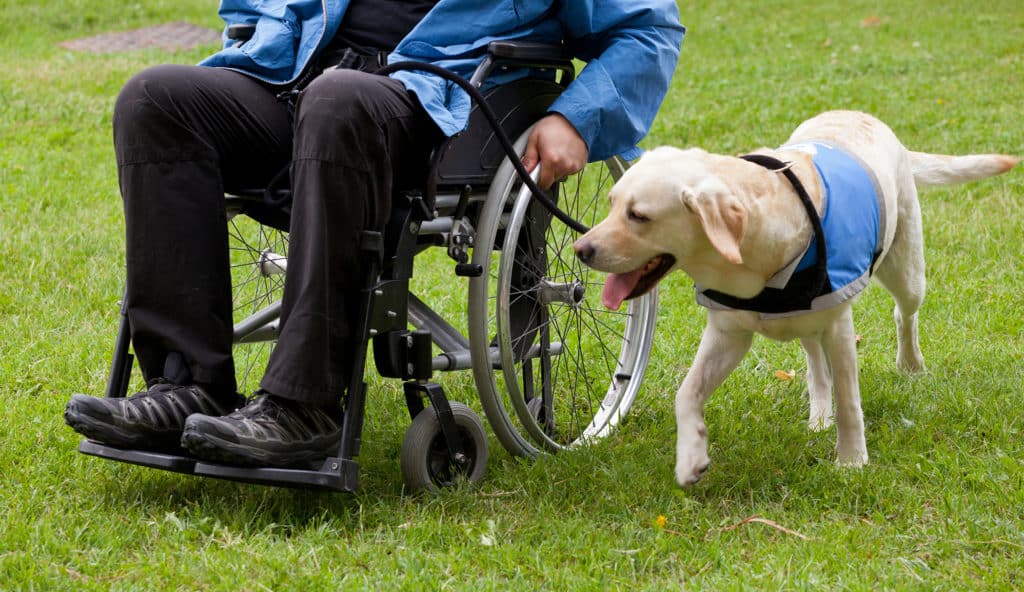While it wouldn’t hurt to have my dog bring in a steady paycheck, her weekly job at hospitals, elementary schools, and assisted living facilities brings untold benefits to the humans with whom she interacts. The joy I receive and the affection she gets from these strangers who are now friends make her job as a therapy dog the best around. Luna is perfectly suited for therapy work. She’s gentle, intuitive, doesn’t bark, is non-reactive around other dogs, and loves nothing more that to receive hugs and positive reinforcement. Therapy work requires a special certification and some specific training and de-sensitization to the sounds of IV pumps beeping, dropped bandage material, or the clatter of wheelchair noise. Some of these “tricks” can be taught, and others are just a part of her genetic makeup. Other pups hard at work and with a special skill set include those that act as service dogs and dogs enlisted as emotional support animals.
What makes these dogs capable of doing their unique jobs and who do they serve?
Emotional Support Animals
Emotional support animals can be any species: dog, cat, chicken, pony, or bird.
They don’t require a special test to receive the designation but must provide their owner therapeutic companionship and deemed necessary by their owner’s physician. Most emotional support animals are strongly bonded to their humans, are obedience trained, and have a calming presence which relieves distress.
Where They’re Permitted
These pets are legally allowed to accompany their owners on airplanes and owners can qualify for no-pet housing if they have a condition requiring their emotional support animal to be present. Otherwise, animals are not permitted access to pet-free public areas and businesses. Because the term “emotional support animal” has been abused over the last several years, housing authorities and airlines often require written documentation of a psychological or emotional diagnosis from a medical professional.
Therapy Dogs
Therapy dogs are enlisted to provide comfort and affection to people in a wide range of facilities including hospitals, hospice centers, schools, and in crises like natural disasters or to relieve other traumatic stress such as during funerals or acts of violence. It has been shown that contact with animals lowers humans’ blood pressure and heart rate, reduces anxiety and increase endorphins and oxytocin – the feel-good chemicals released by the body.
Certifying Therapy Dogs
Therapy dogs require obedience training and an innate gentleness, acceptance of strangers and other pets, and enjoy physical contact. The temperaments of Golden Retrievers and Labradors are often well-suited to therapy work though any breed or mix may possess the appropriate personality for job.
Prior to each therapy visit, handlers must ensure their pets are current on vaccinations and zoonotic disease screening and are clean and well-groomed. Testing and certification are offered through several regional and nationwide organizations including The Bright and Beautiful Foundation, Pet Partners, Alliance of Therapy Dogs, and Therapy Dogs International. Contact the organization to determine what skills your dog must possess to pass the certification test and when testing is offered near you.
Service Animals
Unlike emotional support dogs and therapy animals, service animals like dogs and miniature horses have unrestricted legal access to public spaces and businesses as designated by the Americans with Disabilities Act and local governments. While it is legal for someone to ask if the pet is required due to a disability or what tasks the service dog can perform, they may not ask about the nature of a disability.
Service Dogs vs. Service Animals
Service dogs have a specific job, rigorous training, and certification which permits them to aid their human handler with tasks particular to the person’s disabilities. Service animals are employed to alert an owner when…
- Blood sugar is low
- The onset of seizures is eminent
- Provide room checks for someone with PTSD
- Enable someone with vision loss to cross a street
Many service dogs are trained by Canine Companions for Independence, K9’s for Warriors, and Guide Dogs for the Blind and then adopted by someone with a disability though they can be trained by the owner or another professional dog trainer. Service dogs must be leashed, harnessed, or tethered and strangers should never interrupt a service dog when they are working or without owner’s permission. Service dogs are intelligent, highly trainable, intuitive, loyal, and even-tempered.
While it may seem that the terms emotional support animal, therapy dog, and service dog are interchangeable, make no mistake, these dogs have very different training and certification requirements, legal accessibility rights, and jobs they perform.




